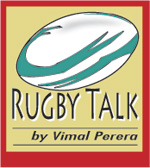Northern hemisphere shows what rugby is made of
View(s):The World Cup is over and by the time you read this the Cup would have been annexed. What is important to note is that this was a World Cup where minnows have come of age. The matches were keenly contested. It was physical, bloody and brutal at times. The stands were either full or close to it in most matches. The numbers that supported were from all countries that played and from those that enjoy rugby. The unsung heroes will be the referees who will always have somebody who knows better. If they penalize they are wrong, if they let the game flow the question is whether they are blind.
 Another that was noted is the gap between northern and southern hemisphere widening with Australia, New Zealand and South Africa squeezed to the semi-final with Argentina running alongside. The game of the southern hemisphere is about more ball handling and skills and the players having more freedom which is giving them confidence. It is in this scenario that we found Japan winning against South Africa. Globalization has changed the game in other ways, too. So far in this tournament, Japan is the only northern hemisphere team to have beaten a southern one, with them beating South Africa.
Another that was noted is the gap between northern and southern hemisphere widening with Australia, New Zealand and South Africa squeezed to the semi-final with Argentina running alongside. The game of the southern hemisphere is about more ball handling and skills and the players having more freedom which is giving them confidence. It is in this scenario that we found Japan winning against South Africa. Globalization has changed the game in other ways, too. So far in this tournament, Japan is the only northern hemisphere team to have beaten a southern one, with them beating South Africa.
This means that Japan, from outside Rugby Championship, has beaten a side that competes at that level. Japan in the next season, will have their Super Rugby franchise. On the other hand, Argentina competed in the Rugby Championship for years and now they will have a Super Rugby side. The effects of globalization of rugby can be seen as the game is reaching over and above the tier one that has dominated. The way to the finals was tough for both finalists, New Zealand and Australia. New Zealand were rattled by the Springbok for most parts of the game and trailed at halftime. The slack in discipline in the second half by the South Africans did damage which lost them the hard won ball at breakdowns. New Zealand defence held for a couple of minutes and warded off the fierce challenge to keep a date with the finals.
All Blacks came to the semi, playing South Africa. This was a great challenge to a Kiwi as this is a game they wanted to win more than any other. To the Springboks it was another encounter against All Blacks which they led at halftime. A little less discipline coast the South Africans a berth in the final. They did make a life difficult before the All Blacks made a date with Australia. The Jackal in Richie McCaw took the better of the opponents at the break down. Once the ball was out Dan Carter was a thrill to watch. The drop goal made a difference of 20 points to 18 victory.
Argentina were willing to run while passing the ball and played best the way they know. Over ambitious in trying daring moves while defending gave away two tries early in the game and let the Wallabies to take a lead. If they were less ambitious and avoided being eccentrics of sorts and little more composure may have seen them home. The third row of the Australians with Pocock leading was a plus factor in the win. The scoreline is no indication of the way the Pumas fought and missed the goal lines at least twice with fancy passes making them lose the ball. With a young side where most will be there in 2019 and some still around 25 in Tokyo the Argentineans are going to be a treat in the next World Cup. Playing on the Super League form next year will give then the experience they need.
The message this World Cup has given so far is that it will be a myth to think that the game will be dominated by the top traditional nations in the years to come. The future will see Argentina and Japan being joined by others in the quest for World Rugby.
The Rugby World Cup this year has seen much contest between the great rugby physical specimens who have also displayed great talent and skills that have adorned the game. The games have been among nations who have been in battle without bodies and waged war without hate promoting the spirit of rugby.
Meanwhile news is that World Rugby is considering a residency eligibility overhaul, asking for the view of all Test-playing nations with the possibility of extending the current period to five or even six years in a bid to stop countries poaching young talent from rival nations. Under current rules, a player must live in the country he wants to represent for 36 consecutive months to be available for Test selection. What will the equation be in the context of players who have crossed borders and made the adopted country stand out? The question is, I believe about money that makes players sign contracts with cash rich clubs and then have claim to play for the National team. For information, nine of the players in the Wallabies’ World Cup squad were not born in Australia.
* Vimal Perera is a former player, coach, referee and an IRB Accredited Referees’ Educator


